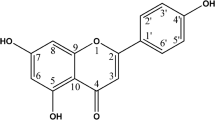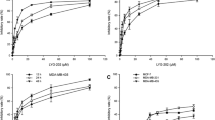Abstract
Background
The tumor suppressor protein p53 is a most promising target for the development of anticancer drugs. Allicin (diallylthiosulfinate) is one of the most active components of garlic (Alliium sativum L.) and possesses a variety of health-promoting properties with pharmacological applications. However, whether allicin plays an anti-cancer role against breast cancer cells through the induction of p53-mediated apoptosis remains unknown.
Methods and results
In this study, we investigate the anti-breast cancer effect of allicin in vitro by using MCF-7 and MD-MBA-231 cells. We found that allicin reduces cell viability, induces apoptosis and cell cycle arrest in both cells. Allicin activated p53 and caspase 3 expressions in both cells but produced different effects on the expression of p53-related biomarkers. In MDA-MB-231 cells, allicin up-regulated the mRNA and protein expression of A1BG and THBS1 while down-regulated the expression of TPM4. Conversely, the mRNA and protein expression of A1BG, THBS1 and TPM4 were all reduced in MCF-7 cells. Hence, allicin induces cell cycle arrest and apoptosis in breast cancer cells through p53 activation but it effects on the expression of p53-related biomarkers were dependent upon the specific type of breast cancer involved.
Conclusions
These findings suggest that allicin induces apoptosis and regulates biomarker expression in breast cancer cell lines through modulating the p53 signaling pathway. Furthermore, our results promote the utility of allicin as compound for further studies as an anticancer drug targeting p53.





Similar content being viewed by others
References
Siegel RL, Miller KD, Jemal A (2018) Cancer statistics, 2018. CA: Cancer J Clin 68:7–30. https://doi.org/10.3322/caac.21442
Del Pup L, Codacci-Pisanelli G, Peccatori F (2019) Breast cancer risk of hormonal contraception: counselling considering new evidence. Crit Rev Oncol Hematol 137:123–130. https://doi.org/10.1016/j.critrevonc.2019.03.001
Aybar DO, Kilic SP, Cinkir HY (2020) The effect of breathing exercise on nausea, vomiting and functional status in breast cancer patients undergoing chemotherapy. Complement Ther Clin 40:101213
Sighoko D, Kamate B, Traore C et al (2013) Breast cancer in pre-menopausal women in West Africa: analysis of temporal trends and evaluation of risk factors associated with reproductive life. Breast 22:828–835. https://doi.org/10.1016/j.breast.2013.02.011
Aggarwal S, Verma SS, Aggarwal S et al (2021) Drug repurposing for breast cancer therapy: old weapon for new battle. Semin Cancer Biol 68:8–20. https://doi.org/10.1016/j.semcancer.2019.09.012
Nowak-Sliwinska P, Scapozza L, Ruizi Altaba A (2019) Drug repurposing in oncology: compounds, pathways, phenotypes and computational approaches for colorectal cancer. BBA—Rev Cancer 1871:434–454
Zheng ZY, Li J, Li, et al (2018) Induction of N-Ras degradation by flunarizine-mediated autophagy. Sci Rep 8:16932. https://doi.org/10.1038/s41598-018-35237-2
Talib WH, Al-hadid SA, Ali MBW et al (2018) Role of curcumin in regulating p53 in breast cancer: an overview of the mechanism of action. BCTT 10:207–217. https://doi.org/10.2147/bctt.s167812
Hussain SA, Panjagari NR, Singh RRB et al (2015) Potential herbs and herbal nutraceuticals: food applications and their interactions with food components. Crit Rev Food Sci 55:94–122. https://doi.org/10.1080/10408398.2011.649148
Almatroodi SA, Alsahli MA, Almatroudi A et al (2019) Garlic and its active compounds: a potential candidate in the prevention of cancer by modulating various cell signalling pathways. Anti-Cancer Agents Med Chem 19:1314–1324. https://doi.org/10.2174/1871520619666190409100955
Ma L, Chen S, Li S et al (2018) Effect of allicin against ischemia/hypoxia-Induced H9c2 myoblast apoptosis via eNOS/NO pathway-mediated antioxidant activity. Evid-Based Compl Alt 320:79–73
Luo R, Fang D, Hang H et al (2016) The mechanism in gastric cancer chemoprevention by allicin. Anti-Cancer Agents Med Chem 16:802–809. https://doi.org/10.2174/1871520616666151111115443
Chen F, Li H, Wang Y et al (2016) Inhibition of allicin in Eca109 and EC9706 cells via G2/M phase arrest and mitochondrial apoptosis pathway. J Funct Foods 25:523–536. https://doi.org/10.1016/j.jff.2016.06.027
Zou X, Liang J, Sun J et al (2016) Allicin sensitizes hepatocellular cancer cells to anti-tumor activity of 5-fluorouracil through ROS-mediated mitochondrial pathway. J Pharmacol Sci 131:233–240. https://doi.org/10.1016/j.jphs.2016.04.017
Zhao D, Tahaney WM, Mazumdar A et al (2017) Molecularly targeted therapies for p53-mutant cancers. Cell Mol Life Sci 74:4171–4187. https://doi.org/10.1007/s00018-017-2575-0
Kruiswijk F, Labuschagne CF, Vousden KH (2015) p53 in survival, death and metabolic health: a lifeguard with a licence to kill. Nat Rev Mol Cell Bio 16:393–405. https://doi.org/10.1038/nrm4007
Liang Y, Zhang JJ, Zhang QB et al (2013) Release test of alliin/alliinase double-layer tablet by HPLC-allicin determination. J Pharm Anal 3:187–192. https://doi.org/10.1016/j.jpha.2012.08.001
Kohl M, Wiese S, Warscheid B (2011) Cytoscape: software for visualization and analysis of biological networks. Methods Mol Biol 696:291–303. https://doi.org/10.1007/978-1-60761-987-1-18
Han A, Moon HG, Kim J et al (2013) Reliability of sentinel lymph node biopsy after neoadjuvant chemotherapy in breast cancer patients. J Breast Cancer 16:378–385. https://doi.org/10.4048/jbc.2013.16.4.378
Clarke RB, Sims AH, Howell A (2008) The origin of estrogen receptor alpha-positive and alpha-negative breast cancer. Adv Exp Med Biol. https://doi.org/10.1007/978-0-387-69080-3-7
Gibson DA, Saunders PTK (2014) Endocrine disruption of oestrogen action and female reproductive tract cancers. Endocr Relat Cancer 21:13–31. https://doi.org/10.1530/erc-13-0342
Ding JN, Kuang P (2021) Regulation of ER alpha stability and estrogen signaling in breast cancer by HOIL-1. Front Oncol 11:664–689
Farvid MS, Chen WY, Michels KB et al (2016) Fruit and vegetable consumption in adolescence and early adulthood and risk of breast cancer: population based cohort study. BMJ Br Med J 353:i2343
Borlinghaus J, Albrecht F, Gruhlke MC et al (2014) Allicin: chemistry and biological properties. Molecules 19:12591–12618
Kim KH, Cho SJ, Kim BO et al (2016) Differential pro-apoptotic effect of allicin in oestrogen receptor-positive or -negative human breast cancer cells. J Funct Foods 25:341–353. https://doi.org/10.1016/j.jff.2016.06.019
Lee CG, Lee HW, Kim BO et al (2015) Allicin inhibits invasion and migration of breast cancer cells through the suppression of VCAM-1: regulation of association between p65 and ER-α. J Funct Foods 15:172–185. https://doi.org/10.1016/j.jff.2015.03.017
Wasylishen AR, Lozano G (2016) Attenuating the p53 pathway in human cancers: many means to the same end: cold spring harb. Perspect Med 6:93–100
Zhan MC, Yu DH, Liu JH et al (2005) Transcriptional repression of protein kinase C alpha via Sp1 by wild type p53 is involved in inhibition of multidrug resistance 1-P-glycoprotein phosphorylation. J Biol Chem 280:4825–4833. https://doi.org/10.1074/jbc.M407450200
Wang X, Wu X, Wang C et al (2010) Transcriptional suppression of breast cancer resistance protein (BCRP) by wild-type p53 through the NF-κB pathway in MCF-7 cells. FEBS Lett 584:3392–3397. https://doi.org/10.1016/j.febslet.2010.06.033
Duffy MJ, Synnott NC, O’Grady S et al (2020) Targeting p53 for the treatment of cancer. Sem Cancer Bio. https://doi.org/10.1016/j.semcancer.2020.07.005
Synnott NC, Bauer MR, Madden S et al (2018) Mutant p53 as a therapeutic target for the treatment of triple-negative breast cancer: Preclinical investigation with the anti-p53 drug, PK11007. Cancer Lett 414:99–106. https://doi.org/10.1016/j.canlet.2017.09.053
Bykov VJN, Eriksson SE, Bianchi J et al (2018) Targeting mutant p53 for efficient cancer therapy. Nat Rev Cancer 18:89–102. https://doi.org/10.1038/nrc.2017.109
Duffy MJ, Synnott NC, Crown J (2017) Mutant p53 as a target for cancer treatment. Eur J Cancer 83:258–265. https://doi.org/10.1016/j.ejca.2017.06.023
Oskarsson T (2013) Extracellular matrix components in breast cancer progression and metastasis. The Breast 22:66–72. https://doi.org/10.1016/j.breast.2013.07.012
Pranavathiyani G, Thanmalagan RR, Devi NL et al (2019) Integrated transcriptome interactome study of oncogenes and tumor suppressor genes in breast cancer. Genes Dis 6:78–87. https://doi.org/10.1016/j.gendis.2018.10.004
Zhao J, Shi L, Zeng S et al (2018) Importin-11 overexpression promotes the migration, invasion, and progression of bladder cancer associated with the deregulation of CDKN1A and THBS1. Urol Oncol Semin Orig Investig 36:1–13
Wu MP, Wu LW, Chou CY (2016) The anticancer potential of thrombospondin-1 by inhibiting angiogenesis and stroma reaction during cervical carcinogenesis. Gynecol Minim Invasive Ther 5:48–53. https://doi.org/10.1016/j.gmit.2015.09.001
Jayachandran A, Anaka M, Prithviraj P, at al, (2014) Thrombospondin1 promotes an aggressive phenotype through epithelial-to-mesenchymal transition in human melanoma. Oncotarget 5:5782–5797. https://doi.org/10.18632/oncotarget.2164
Cinatl J, Kotchetkov R, Scholz M et al (1999) Human cytomegalovirus infection decreases expression of thrombospondin-1 independent of the tumor suppressor protein p53. Am J Pathol 155:285–292. https://doi.org/10.1016/s0002-9440(10)65122-x
Rostila A, Puustinen A, Toljamo T et al (2012) Peroxiredoxins and tropomyosins as plasma biomarkers for lung cancer and asbestos exposure. Lung Cancer 77:450–459. https://doi.org/10.1016/j.lungcan.2012.03.024
Lin XD, Chen SQ, Qi YL et al (2012) Overexpression of thrombospondin-1 in stromal myofibroblasts is associated with tumor growth and nodal metastasis in gastric carcinoma. J Sur Oncol 106:94–100. https://doi.org/10.1002/jso.23037
Heydari N, Nikbakhsh N, Sadeghi F et al (2018) Overexpression of serum MicroRNA-140-3p in premenopausal women with newly diagnosed breast cancer. Gene 655:25–29. https://doi.org/10.1016/j.gene.2018.02.032
Uen YH, Lin KY, Sun DP et al (2013) Comparative proteomics, network analysis and post-translational modification identification reveal differential profiles of plasma Con A-bound glycoprotein biomarkers in gastric cancer. J Proteomics 83:197–213. https://doi.org/10.1016/j.jprot.2013.03.007
Tolek A, Wongkham C, Proungvitaya S et al (2012) Serum alpha(1)beta-glycoprotein and afamin ratio as potential diagnostic and prognostic markers in cholangiocarcinoma. Exp Biol Med 237:1142–1149. https://doi.org/10.1258/ebm.2012.012215
Abdul-Rahman PS, Lim B-K, Hashim OH (2007) Expression of high-abundance proteins in sera of patients with endometrial and cervical cancers: analysis using 2-DE with silver staining and lectin detection methods. Electrophoresis 28:1989–1996. https://doi.org/10.1002/elps.200600629
Geeves MA, Hitchcock-DeGregori SE, Gunning PW (2015) A systematic nomenclature for mammalian tropomyosin isoforms. J Muscle Res Cell M 36:147–153. https://doi.org/10.1007/s10974-014-9389-6
Yang R, Zheng G, Ren D et al (2018) The clinical significance and biological function of tropomyosin 4 in colon cancer. Biomed Pharmacother 101:1–7. https://doi.org/10.1016/j.biopha.2018.01.166
Prager-Khoutorsky M, Goncharov I, Rabinkov A et al (2007) Allicin inhibits cell polarization, migration and division via its direct effect on microtubules. Cell Motil Cytoskelet 64:321–337. https://doi.org/10.1002/cm.20185
Sela U, Ganor S, Hecht I et al (2004) Allicin inhibits SDF-1α-induced T cell interactions with fibronectin and endothelial cells by down-regulating cytoskeleton rearrangement, Pyk-2 phosphorylation and VLA-4 expression. Immunology 111:391–399
Miron T, Mironchik M, Mirelman D et al (2003) Inhibition of tumour growth by a novel approach: in situ allicin generation using targeted alliinase delivery. Mol Cancer Ther 2:1295–1301
Funding
This study was funded by the foundation of the Key Laboratory of Active Components of Xinjiang Natural Medicine and Drug Release Technology [Grant No: XJDX1713].
Author information
Authors and Affiliations
Contributions
GM contributed to the design of the study, wrote the manuscript, and analyzed the data. MA revised the manuscript and contributed to the design of the study. ZA contributed to analyzing the data. XL made substantial contributions to the conception and design of the present study and revised the manuscript. All authors read and approved the final manuscript.
Corresponding author
Ethics declarations
Conflict of interest
The authors have no competing interests to declare.
Consent to participate
All authors have given their consent to participate in this report and submit it to Molecular Biology Reports.
Consent to publish
All authors have given their consent to publish this report in the Molecular Biology Reports.
Additional information
Publisher's Note
Springer Nature remains neutral with regard to jurisdictional claims in published maps and institutional affiliations.
Supplementary Information
Below is the link to the electronic supplementary material.
11033_2021_6722_MOESM1_ESM.tif
Supplementary file1 Fig. S1. Chromatography of allicin. The concentration of allicin stock solution was determined by HPLC, allicin was separated following the elution program of 60% methanol and 40%, 1% formic acid (TIF 692 kb)
11033_2021_6722_MOESM2_ESM.tif
Supplementary file2 Fig. S2. The dose-dependent effects of allicin on morphology of breast cancer cells (24h, ×100) (TIF 11565 kb)
Rights and permissions
About this article
Cite this article
Maitisha, G., Aimaiti, M., An, Z. et al. Allicin induces cell cycle arrest and apoptosis of breast cancer cells in vitro via modulating the p53 pathway. Mol Biol Rep 48, 7261–7272 (2021). https://doi.org/10.1007/s11033-021-06722-1
Received:
Accepted:
Published:
Issue Date:
DOI: https://doi.org/10.1007/s11033-021-06722-1




